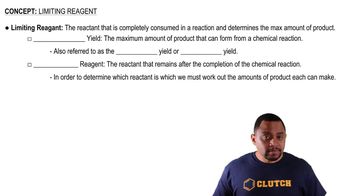A method used by the U.S. Environmental Protection Agency (EPA) for determining the concentration of ozone in air is to pass the air sample through a 'bubbler' containing sodium iodide, which removes the ozone according to the following equation: O31g2 + 2 NaI1aq2 + H2O1l2¡ O21g2 + I21s2 + 2 NaOH1aq2 (b) How many grams of sodium iodide are needed to remove 1.3 mg of O3?
A mixture of N21g2 and H21g2 reacts in a closed container to form ammonia, NH31g2. The reaction ceases before either reactant has been totally consumed. At this stage 3.0 mol N2, 3.0 mol H2, and 3.0 mol NH3 are present. How many moles of N2 and H2 were present originally?
 Verified step by step guidance
Verified step by step guidance
Verified video answer for a similar problem:
Key Concepts
Stoichiometry

Limiting Reactant

Chemical Equilibrium

The fat stored in a camel's hump is a source of both energy and water. Calculate the mass of H2O produced by the metabolism of 1.0 kg of fat, assuming the fat consists entirely of tristearin 1C57H110O62, a typical animal fat, and assuming that during metabolism, tristearin reacts with O2 to form only CO2 and H2O.
A mixture containing KClO3, K2CO3, KHCO3, and KCl was heated, producing CO2, O2, and H2O gases according to the following equations: 2 KClO31s2¡2 KCl1s2 + 3 O21g2 2 KHCO31s2¡K2O1s2 + H2O1g2 + 2 CO21g2 K2CO31s2¡K2O1s2 + CO21g2 The KCl does not react under the conditions of the reaction. If 100.0 g of the mixture produces 1.80 g of H2O, 13.20 g of CO2, and 4.00 g of O2, what was the composition of the original mixture? (Assume complete decomposition of the mixture.) How many grams of K2CO3 were in the original mixture?
When a mixture of 10.0 g of acetylene (C2H2) and 10.0 g of oxygen (O2) is ignited, the resulting combustion reaction produces CO2 and H2O. (c) How many grams of CO2 and H2O are present after the reaction is complete?
When a mixture of 10.0 g of acetylene (C2H2) and 10.0 g of oxygen (O2) is ignited, the resulting combustion reaction produces CO2 and H2O. (c) How many grams of C2H2 are present after the reaction is complete?
